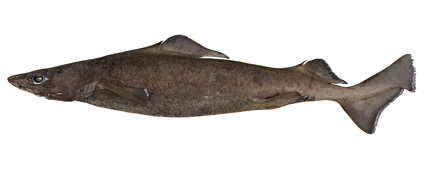Leafscale Gulper Shark, Centrophorus squamosus (Bonnaterre 1788)
Other Names: Deepsea Spiny Dogfish, Nilsons Deepsea Dogfish, Nilson's Deepsea Dogfish

A Leafscale Gulper Shark, Centrophorus squamosus. Source: CSIRO National Fish Collection. License: CC BY Attribution
Summary:
A large dark grey to chocolate brown gulper shark with a short broad snout, a long low first dorsal fin (lower in height than second dorsal fin), short pectoral rear tips, and large, rough, leaf-like denticles.
Cite this page as:
Bray, D.J. 2025, Centrophorus squamosus in Fishes of Australia, accessed 03 Jul 2025, https://fishesofaustralia.net.au/home/species/2003
Leafscale Gulper Shark, Centrophorus squamosus (Bonnaterre 1788)
More Info
|
Distribution |
South-east New South Wales, Victoria and Tasmania. Elsewhere, the species is widespread with a patchy distribution in the Atlantic, Indian, and Pacific Oceans. Demersal and pelagic on continental and insular shelves and slopes to the abyss at depths of 0–3,366 m, mostly at depths >200 m. |
|
Features |
Centrophorus squamosus has large, overlap-ping, leaf-shaped dermal denticles that are uniqueamongst Centrophorus and that make this species easilydistinguishable from all other gulper sharks regard-less of size. |
|
Biology |
Gulper sharks are known for their slow life histories and targeted fisheries for the species have collapsed over a relatively short time (<20 years). The species is aplacental viviparous (ovoviviparous) with 5 to 8 young born at a length between 35 and 43 cm TL. Males mature at approx. 100 cm TL, and females at approx. 125 cm TL. |
|
Fisheries |
Although much of the species' distribution overlaps with intensive fishing activities, but the species may find some refuge at depth. Taken as target and incidental catch in small scale and industrial fisheries using a variety of fishing gear. The species is retained for its liver oil, which is considered among the most valuable of shark liver oil and is an important marine resource for local communities. Catches in Australia and Oceania are relatively low and are not a significant component of the squaloid catch in both southeastern Australia and New Zealand. Globally, the Leafscale Gulper Shark is estimated to have reduced by 50–79% over the last three generations (158–160;years). |
|
Conservation |
|
|
Similar Species |
Easily distinguished by the large, overlapping, leaf-shaped dermal denticles. The denticles are unique among Centrophorus spp., and differ from all other gulper sharks regard-less of size. |
|
Etymology |
The specific name is from the Latin squamosus (= covered in scales, scaled, scaly), in reference to the large scales covering this species. |
|
Species Citation |
Squalus squamosus Bonnaterre, 1788, Tableau Encyclopédique et Méthodique des trois Règnes de la Nature : 12. Type locality: north-east Atlantic. |
|
Author |
Bray, D.J. 2025 |
|
Resources |
Leafscale Gulper Shark, Centrophorus squamosus (Bonnaterre 1788)
References
Bonnaterre, J.P. 1788. Tableau Encyclopédique et Méthodique des trois Règnes de la Nature. Ichthyologie. Paris. pp. 1-215, 102 pls
Clarke, M.W., Connolly, P.L. and Bracken, J.J. 2002. Age estimation of the exploited deepwater shark Centrophorus squamosus from the continental slopes of the Rockall Trough and Porcupine Bank. Journal of Fish Biology 60: 501-514.
Compagno, L.J.V. 1984. FAO Species Catalogue. Sharks of the World. An annotated and illustrated catalogue of shark species known to date. Hexanchiformes to Lamniformes. FAO Fisheries Synopsis No. 125. Rome : FAO Vol. 4(1) pp. 1-249.
Compagno, L.J.V., Dando, M. & Fowler, S. 2005. A Field Guide to the Sharks of the World. London : Collins 368 pp.
Compagno, L.J.V. & Niem, V.H. 1998. Squalidae. In: K.E. Carpenter and V.H. Niem (eds). FAO species identification guide for fishery purposes. The living marine resources of the Western Central Pacific. Volume 2. Cephalopods, crustaceans, holothurians and sharks. FAO, Rome, pp. 1213-1232.
Ebert, D.A., Compagno, L.J.V. & Cowley, P.D. 1991. A preliminary investigation of the feeding ecology of squaloid sharks off the west coast of southern Africa. South African Journal of Marine Science 12: 601-609.
Finucci, B., Rigby, C.L., Bineesh, K.K., Cheok, J., Cotton, C.F., Kulka, D.W., Neat, F.C., Pacoureau, N., Rohner, C.A., Tanaka, S. & Walker, T.I. 2024. Centrophorus squamosus. The IUCN Red List of Threatened Species 2024: e.T41871A254975849. https://dx.doi.org/10.2305/IUCN.UK.2024-2.RLTS.T41871A254975849.en. Accessed on 26 May 2025.
Garrick, J.A.F. 1959. Studies on New Zealand Elasmobranchii. Part VII — The identity of specimens of Centrophorus from New Zealand. Transactions of the Royal Society of New Zealand 86(1,2): 127-141 figs 1-5
Graham, K.J., Andrew, N.L. & Hodgson, K.E. 2001. Changes in the relative abundances of sharks and rays on Australian South East Fishery trawl grounds after twenty years of fishing. Marine and Freshwater Research 52: 549-561.
Last, P.R., Scott, E.O.G. & Talbot, F.H. 1983. Fishes of Tasmania. Hobart : Tasmanian Fisheries Development Authority 563 pp. figs.
Last, P.R. & Stevens, J.D. 1994. Sharks and Rays of Australia. Canberra : CSIRO Australia 513 pp. 84 pls.
Last, P.R. & Stevens, J.D. 2009. Sharks and Rays of Australia. Collingwood : CSIRO Publishing Australia 2, 550 pp.
Moura, T., E. Jones, M.W. Clarke, C.F. Cotton, P. Crozier, et al. 2014. Large-scale distribution of three deep-water squaloid sharks: Integrating data on sex, maturity and environment. Fisheries Research 157: 47–61.
Thompson, E.F. 1930. New records of the genera Centrophorus and Hoplichthys in New Zealand. Records of the Canterbury Museum 3(4): 275-279 figs 42-44 (described as Centrophorus nilsoni, type locality off Kaikoura, New Zealand.

